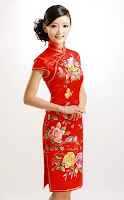Chapter Two
Shanghai Qipao: Grace Its Elegance
Qipao, called Cheongsam in English, is a traditional Chinese female dress with distinctive Chinese features and enjoys a growing popularity in the international world of high fashion. It is said that Qipao is the earliest fashion for women in Shanghai. --Nowadays, it not only represents Chinese female costume but also becomes a symbol of the oriental traditional costume.
Why do Chinese people like to wear the Qipao? The main reason is that it fits well the female figure, has simple lines and looks elegant. What's more, it is suitable for wearing in all seasons by old and young.
The beauty of the Qipao is that it creates an impression of simple and quiet charm, elegance and neatness. --The cheongsam can either be long or short, unlined or interlined, woolen or made of silk floss. Besides, with different materials, the cheongsam presents different styles. Qipao made of silk with patterns of flowerlet, plain lattices or thin lines demonstrate charm of femininity and staidness. Those made of brocade are eye-catching and magnificent and suitable for occasions of greeting guests and attending banquets.
- Styles of Qipao
Different ages have different fashions, let alone Qipao which has been experiencing constant changes. There are varied styles of Qipao.
The first and "traditional" Qipao as introduced to the larger Han population were wide, baggy and rather loose. It covered most of the women's body. After years’ improvements, features of Qipao are: straight collar, right placket, tight waist, knee-length and slits on both sides. Either be long-sleeved or short-sleeved.
 |
| Styles of Qipao |
The neck styles: high-neck, low-neck and neck-less styles.
The Sleeves: long-sleeve to short-sleeve and sleeveless.
The Slits: high and low-slit styles.
The Placket Patterns: Ruyi plackets, Pipa plackets, Slant-cut plackets and double plackets, etc.
The Fancy Patterns on Qipao:
 |
| Peony on Qipao |
- Lotus: symbolizes beauty and purity
- Chrysanthemum: symbolizes longevity
- Fish: a symbol for prosperity
- Dragon: symbolizes "Supreme Power"
- Phoenix: beauty and purity.
- History of Qipao in Shanghai
Qipao is the classic element of Shanghai. With its hundred year history, Qipao shows the history of Shanghai as well.
In the beginning, women in Shanghai altered the traditional long shirt into the weskit. After 1927, imitating the western women, they started to wear the overcoat.
From the 1930s, Qipao almost became the uniform for women. Folk women, students, workers and highest-tone women all dressed themselves in Qipao, which even became a formal suit for occasions of social intercourses or diplomatic activities.
 |
| Tang wear Qipao |
At the end of the 1940s, cheongsam was extremely popular with the Chinese people. Almost every city woman owned one or two cheongsams, regardless of social status or figure. Then there emerge various forms of cheongsams we see today that emphasize color decoration and set off the beauty of the female shape.
By the end of the 1950s, cheongsam was replaced by the Chinese tunic suit and Mao jacket. Since then, cheongsam only appeared for exclusive foreign affairs activities. It was not until the early 1980s that the garb was again seen in public places.
Today, Qipao is synonymous with China--many female Chinese film stars regard cheongsam as their first choice when attending important occasions. For example, international film festivals like the Academy Awards, Venice, and Cannes, at the Miss World contest and in international model competitions, etc.
 |
| Children wear Qipao |
At present, cheongsam can be seen in many Chinese TV shows, and in many Chinese-language films, such as Lust, Caution, Rouge, The Flowers of Shanghai, Center Stage, Eighteen Springs, and In the Mood for Love.
Not only the stars of China, but also common people like to wear Qipao.-- They are worn at diverse events as evening wear by the bride in traditional Chinese weddings, in the entertainment and hospitality industries, and even raves.
The cheongsam and Qipao is a classic dress that continues to inspire new designs from top designers around the world. Thus, no wonder it is so much liked by women not only of China but of foreign countries as well.
--In a word, Qipao shows the grace of women perfectly and its elegance adds the charms of women.

No comments:
Post a Comment
Thanks for your comment and welcome to China!